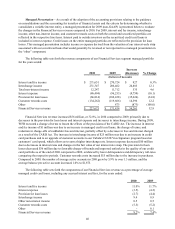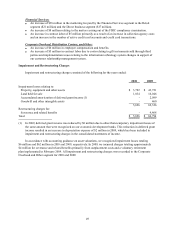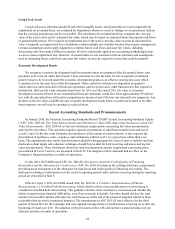Cabela's 2011 Annual Report Download - page 65
Download and view the complete annual report
Please find page 65 of the 2011 Cabela's annual report below. You can navigate through the pages in the report by either clicking on the pages listed below, or by using the keyword search tool below to find specific information within the annual report.55
available or at unattractive rates. Our ability to issue certificates of deposit is reliant on our current regulatory
capital levels. WFB is classified as a “well capitalized” bank, the highest category under the regulatory framework
for prompt corrective action. If WFB were to be classified as an “adequately capitalized” bank, which is the next
level category down from “well capitalized,” we would be required to obtain a waiver from the FDIC in order to
continue to issue certificates of deposit. We will invest additional capital in WFB, if necessary, in order for WFB
to continue to meet the minimum requirements for the “well-capitalized” classification under the regulatory
framework for prompt corrective action. In addition to the non-brokered certificates of deposit market to fund
growth and maturing securitizations, we have access to the brokered certificates of deposit market through multiple
financial institutions for liquidity and funding purposes.
The ability of our Financial Services business to engage in securitization transactions on favorable terms
or at all could be adversely affected by disruptions in the capital markets or other events, which could materially
affect our business and cause our Financial Services business to lose an important source of capital. The Reform
Act, which was signed into law in July 2010, will also affect a number of significant changes relating to asset-
backed securities, including additional oversight and regulation of credit rating agencies and additional reporting
and disclosure requirements. The changes resulting from the Reform Act may impact our profitability, require
changes to certain of WFB’s business practices, impose upon WFB more stringent capital, liquidity, and leverage
ratio requirements, increase FDIC deposit insurance premiums, or otherwise adversely affect WFB’s business.
These changes may also require WFB to invest significant management attention and resources to evaluate and
make necessary changes. On September 27, 2010, the FDIC approved a final rule that, subject to certain conditions,
preserved the safe-harbor treatment for legal isolation of transferred assets applicable to certain grandfathered
revolving trusts and master trusts that had issued at least one series of asset-backed securities as of such date,
which we believe included the Trust. The final rule imposes significant new conditions on the availability of the
safe-harbor with respect to securitizations that are not grandfathered.
In addition, several rules and regulations have recently been proposed or adopted that may substantially affect
issuers of asset-backed securities. On September 19, 2011, the SEC proposed a new rule under the Securities Act
of 1933, as amended, to implement certain provisions of the Reform Act. Under the proposed rule, an underwriter,
placement agent, initial purchaser, or sponsor of an asset-backed security, or any affiliate of any such person,
shall not at any time within one year after the first closing of the sale of the asset-backed security, engage in
any transaction that would involve or result in any material conflict of interest with respect to any investor in a
transaction arising out of such activity. The proposed rule would exempt certain risk-mitigating hedging activities,
liquidity commitments, and bona fide market-making activity. It is not clear how the final rule will differ from the
proposed rule, if at all. The final rule’s impact on the securitization market and WFB is also unclear at this time.
The Trust is structured to come within the exemption from the Investment Company Act provided by
Investment Company Act Rule 3a-7. On August 31, 2011, the SEC issued an advance notice of proposed rulemaking
regarding possible amendments to Investment Company Act Rule 3a-7. At this time, it is uncertain what form the
related proposed and final rules will take, whether the Trust would continue to be eligible to rely on the exemption
provided by Investment Company Act Rule 3a-7, and whether the Trust would qualify for any other Investment
Company Act exemption.
On July 26, 2011, the SEC re-proposed certain rules for asset-backed securities offerings (“SEC Regulation
AB II”) which were originally proposed by the SEC on April 7, 2010. If adopted, SEC Regulation AB II would
substantially change the disclosure, reporting, and offering process for private offerings of asset-backed securities
that rely on the Rule 144A safe harbor, including the Trust’s private offerings of asset-backed securities. As
currently proposed, SEC Regulation AB II would, among other things, alter the safe harbor standards for private
placements of asset-backed securities imposing informational requirements similar to those applicable to registered
public offerings. The final form that SEC Regulation AB II may take is uncertain at this time, but it may impact
WFB’s ability and/or desire to sponsor securitization transactions in the future.
On March 29, 2011, pursuant to the provisions of the Reform Act, the SEC, the Federal Reserve, the FDIC,
and certain other federal agencies issued proposed regulations requiring securitization sponsors to retain an
economic interest in assets that they securitize. Subject to certain exceptions, the proposed regulations would
























